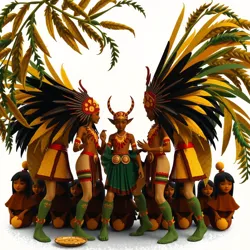Dance of the Earth Spirits
The Dance of the Earth Spirits is an ancient fertility ritual performed by various indigenous cultures to honor and seek blessings from the earth. Rooted in the belief that the earth is a living entity with spiritual powers, this dance is both a celebration of nature's abundance and a plea for continued fertility.

Origins and History
The origins of the Dance of the Earth Spirits can be traced back to early agrarian societies where communities depended heavily on successful harvests. These societies developed rituals to communicate with earth spirits, believed to control the fertility of the land. The dance was an opportunity to express gratitude and ensure the spirits' favor for future planting seasons.
The ritual typically takes place during the planting season or at the harvest's end, symbolizing the cycle of growth and renewal. Archaeological findings suggest that similar dances were performed during Neolithic celebrations, where communal gatherings reinforced social bonds and spiritual beliefs.
Ritual Elements
Dance and Music
The dance itself involves intricate steps and movements that mimic the cycles of nature, such as the sowing of seeds and the growth of plants. Participants adorn themselves with costumes made from natural materials, such as leaves, feathers, and earth-toned fabrics, to embody the spirits they seek to honor.
Traditional instruments, including drums and flutes, provide a rhythmic accompaniment that guides the dancers. The music is intended to evoke the sounds of nature, creating an immersive experience that transports participants and spectators alike into a spiritual realm.
Offerings and Symbols
Offerings play a crucial role in the Dance of the Earth Spirits. Participants present gifts to the earth, such as grains, fruits, and flowers, symbolizing their dependence on nature's benevolence. These offerings are carefully arranged around a central altar, often decorated with symbols of fertility like spirals and circles.
Cultural Significance
The Dance of the Earth Spirits holds significant cultural importance as it reinforces community identity and continuity. By participating in this ritual, individuals connect with their ancestors and reaffirm their commitment to maintaining harmony with the natural world. The dance also serves as an educational tool, passing down traditional knowledge and values to younger generations.
In many cultures, the dance is seen as a time of unity and celebration, where differences are set aside to honor a shared heritage. This sense of community is mirrored in other rituals, such as the Journey of the Sun Ceremony, which also emphasizes collective participation and spiritual growth.
Influence on Modern Practices
Today, the Dance of the Earth Spirits continues to be celebrated, often incorporated into contemporary festivals that highlight cultural heritage. These modern adaptations maintain the dance's core themes of gratitude and respect for nature while embracing new artistic expressions.
The preservation of such rituals is vital for cultural continuity, providing communities with a means to celebrate their identity in an ever-changing world. Similar endeavors, like the revival of the Harvest Moon Dance, demonstrate the enduring relevance of ancient rituals in today's society.
See Also
- Neolithic Celebrations
- Journey of the Sun Ceremony
- Harvest Moon Dance
References
- Neolithic Celebrations
- Journey of the Sun Ceremony
- Harvest Moon Dance
The Dance of the Earth Spirits remains a powerful symbol of humanity's connection to the natural world, celebrating the cycles of life and the enduring spirit of community.